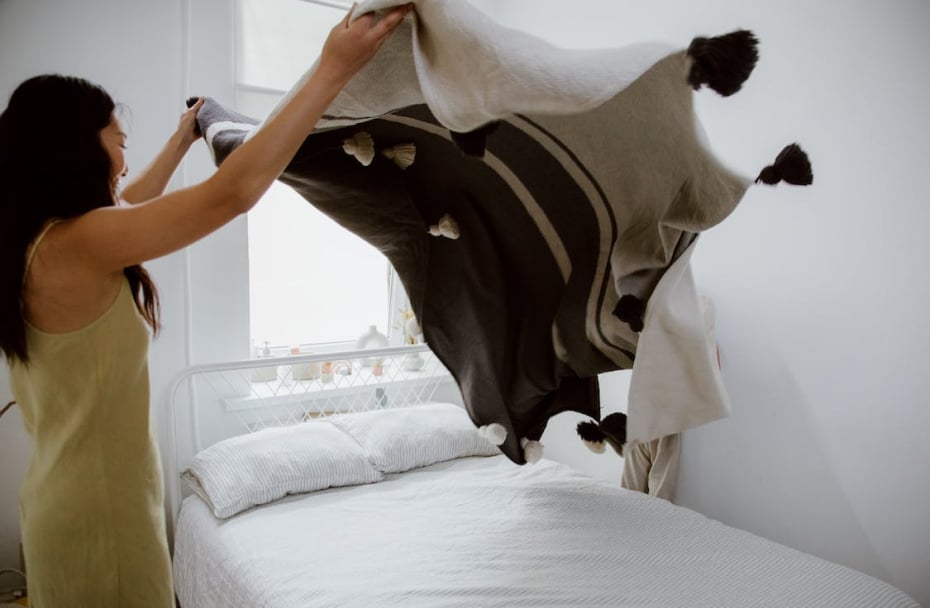

Coming home to discover your mattress has been soaked can be anyone’s worst nightmare. But don't worry, Noah, it's not a sign to start building an ark just yet! Whether it was an accidental spill of coffee, a little one's nighttime accident, an unexpected leak, or a pet misbehaving, there's a way to turn that damp bed back into the cozy sleep haven you know and love. In this guide, we're diving deep into the art of drying a mattress. So, if you’re wondering how to dry a wet bed mattress as fast as possible or even how to get dog pee out of your mattress, then look no further than this guide! Roll up your sleeves, and let's get started – your dry, comfy bed awaits!
Key Takeaways
- Quick action is crucial in preventing the growth of mold and mildew in a wet mattress.
- Various household items, such as fans, towels, and baking soda, can be surprisingly effective in the mattress drying process.
- Each mattress type, whether memory foam, innerspring, or latex, requires specific drying techniques for best results.
- Unexpected methods like using cat litter or walking on towels can go a long way in helping you achieve a dry bed.
- A mattress protector can significantly reduce the possibility of future moisture-related issues and save you from buying a new mattress.
How to Prepare for Drying a Mattress
When faced with a wet mattress, the first step is not to panic. Instead, it's time to gather your mattress-drying toolkit. You’ll need absorbent towels (yes, all those old beach towels nobody uses anymore will finally come in handy), a vacuum that can handle wet conditions, fans or a hairdryer for some direct airflow, and a dehumidifier if you have one available. If you’re dealing with a memory foam mattress, remember to be gentle, as the foam material is extra sensitive. Finally, grab your trusty baking soda.
Step-by-Step Process on How to Dry Your Mattress
Memory Foam Mattress
Step 1: Gentle Blotting
Gently press towels into the mattress to soak up as much moisture as possible. Be as gentle as if you were patting a baby to sleep.
Step 2: Baking Soda
Powder the mattress with a generous amount of baking soda over the wet area. If you’ve already checked out our guide on how to clean and dry a memory foam mattress, then you’ll know that this wonderful ingredient doesn’t just kill odors – it's great for absorbing moisture too.
Step 3: Air Circulation
Place fans around the mattress or position it near an open window with some sunshine. Think of it as giving your mattress a day at the beach, minus the sand and sunburn.
Innerspring Mattress (Traditional Mattress)
Step 1: Grab Those Towels
Remove all the bedding and apply some towels to absorb the moisture, putting in some good old-fashioned elbow grease. These can be either paper towels or regular towels you no longer use, but the latter will be more effective. You can also gently walk on top of the mattress, stepping on the towels to ensure all the moisture gets properly absorbed.
Step 2: Sun Blast
If you can, let your mattress enjoy some sunlight. Sit it on both sides and flip it throughout to ensure the entire mattress dries. The sun also acts as a natural disinfectant for your mattress to keep all those nasty germs at bay.
Step 3: Vacuum Finish
Use a wet-dry vacuum to suck out any lingering dampness. Run the nozzle of your vacuum over the wet parts in even and long strokes until you're confident that all the moisture has been fully absorbed.
Step 4: Ventilate Well
Again, let the mattress sit outside if possible to eliminate any lingering odors that remain dormant. Flip every now and then for maximum coverage.
Latex or Futon Mattress
Step 1: Soft and Slow
Blot gently with towels. Latex is delicate and requires a light touch – like handling a fragile antique.
Step 2: Hair Dryer on Low
Use a hairdryer on a low setting to aid in drying the mattress. Keep it moving to avoid damaging the latex.
Step 3: Dehumidifier Magic
If you have a dehumidifier, you can finally put it to work. For a more in-depth take, be sure you’ve also memorized our exhaustive guide on how to clean a futon mattress.
Tips on Keeping Your Mattress Dry
Now that your mattress is all dry and toasty, let’s keep it that way! Here are some general tips you can follow to keep your mattress dry and long-lasting:
Using a Hair Dryer
For spot drying, especially when dealing with patchy wet spots, a hair dryer can be a great mattress dryer, too. Using it on a low heat setting helps dry out these patches evenly and quickly.
Kitty Litter for Absorption
A lesser-known yet effective method of drying your mattress is using kitty litter. Spread a thick layer of kitty litter over the damp areas and cover the litter with a towel. Now, firmly press on the towel and watch as the litter does its magic. Finally, vacuum or brush it off the mattress.
Baking Soda for Freshness and Longevity
Sprinkling baking soda over the damp areas is a two-fold solution. It not only helps absorb moisture but also neutralizes odors, which is especially useful in cases of bedwetting or pet accidents. You should absolutely keep yourself up to date with the best techniques on how to dry out a mattress after bedwetting. This approach is highlighted by many for its effectiveness in both drying and keeping your mattress as fresh as a bed of flowers.
Ensuring a Thorough Dry
Allowing your mattress to air dry is really important, so be sure to air it out every few months. Ideally, it should be located near a well-ventilated area like an open window, for example. If possible, letting it sit in direct sunlight can significantly speed up the drying process, as the sun naturally helps to evaporate the moisture and acts as a disinfectant.
Mattress Protection
Investing in a high-quality mattress protector is one of the best things you can do to prevent any further disasters. So, as long as you know how to wash your mattress protector, your bed is in safe hands!
Final Thoughts
After all is said and done, drying a mattress is a game of patience, a bit of physical effort, and some clever tricks with your household items. Who knew that the humble baking soda sitting in your kitchen cabinet was such a powerhouse in mattress drying?
Preparation is key - knowing how to quickly dry a soaked mattress that got rained on can save the day! Furthermore, a good mattress protector can be your best friend, turning potential disasters into minor hiccups. And let's not forget the importance of regular mattress check-ups. Remember, act fast, use what you have at home, and always be mindful of how you can prevent future mishaps. This is the best and fastest way to dry a mattress.
So cheers to that – may your sleep be as peaceful as the calmest sea and your mattress as dry as the dunes of the driest desert.
Frequently Asked Questions
How long does it take for a mattress to dry?
Generally speaking, you're looking at around 6 to 8 hours for a mattress to dry out completely – but this all depends on various factors, such as the type of mattress and ventilation. Take memory foam mattresses, for example. Thanks to their dense, cozy structure that we all love, they tend to hog moisture a bit longer than their less luxurious counterparts. So, will a wet mattress dry out overnight? Yes, as long as it is well-aired.
Is a wet mattress ruined?
Not necessarily, but you’ll need to act fast! Quick drying of a wet mattress can indeed rescue it. However, if mold and mildew get a foothold, then there isn’t much that can be done at that point. Visible stains, mold growth, unpleasant odors, and the loss of shape or support are also some telltale signs that your mattress might need to be ditched.
Can I sleep on a damp mattress?
Rest assured, sleeping on a damp mattress is a definite no-go. As mentioned earlier, it can become a breeding ground for mold, leading to some unpleasant health issues. Patience is key – know how to get the water out of your mattress completely to be on the safe side.
How do you know if your mattress has mold?
Be on the lookout for some of the most classic signs of mold growth on your mattress, such as the appearance of black, green, or white spot marks. A musty smell is another giveaway. Identifying these early on will ensure you act fast, preventing further problems and keeping your sleeping space safe and fresh.
Why is my mattress wet underneath?
If you’re feeling that your mattress is feeling a bit soggy on the underside, this could be due to several factors: sweating during sleep, high humidity in your room, or even a lack of proper air circulation could all be culprits. Remember, adequate ventilation is key, so a bit of extra sunlight can go a long way in ensuring it's dry through and through. And that pesky humidity? Consider investing in a high-quality dehumidifier. Not only will this keep excess moisture from accumulating in your mattress, but it will do wonders for your breathing and respiratory health.
![How to Get Vomit Out of Your Mattress [Stain & Smell Solutions]](/storage/web/source/1/pL6ZIMCmAC97BEyoEjQfP86wJt2XjC5B.jpg)
![How to Get Sweat Smell Out of Your Mattress: [Clean Sleep]](/storage/web/source/1/DnSNEP7a--FLKDtoGY80VXUjg9tg0nrx.jpg)
![How to Get Yellow Stains Out of Your Mattress [Effective Tips]](/storage/web/source/1/kD-X9LJnVrpGB7pcWsf88L-h3iFv9eBk.jpg)

